Strategic Asset Management Report: Power Sector Literature Review
VerifiedAdded on 2023/01/13
|12
|3011
|90
Report
AI Summary
This report delves into the critical aspects of strategic asset management within the power sector. It begins with an introduction highlighting the challenges faced by power utilities, such as aging infrastructure and the need for technological advancements, and emphasizes the importance of effective asset management to optimize costs, risks, and performance. The report then presents an annotated bibliography of journal articles, each focusing on different facets of asset management strategies. These articles cover topics like improving investment sustainability in PPP power projects, developing a best practice asset management framework for electrical power distribution organizations, and reviewing asset management in distribution systems in Latin America. The report also discusses key findings and best practices derived from the literature, including the importance of long-term government commitment, maturity models for assessing asset management capabilities, and the role of digital disruption. The conclusion summarizes the key takeaways and emphasizes the need for continuous improvement and adherence to standards like ISO 55000 to enhance asset management practices in the power sector. The report aims to provide insights into current research and practical applications of strategic asset management to improve the efficiency and effectiveness of power utilities.
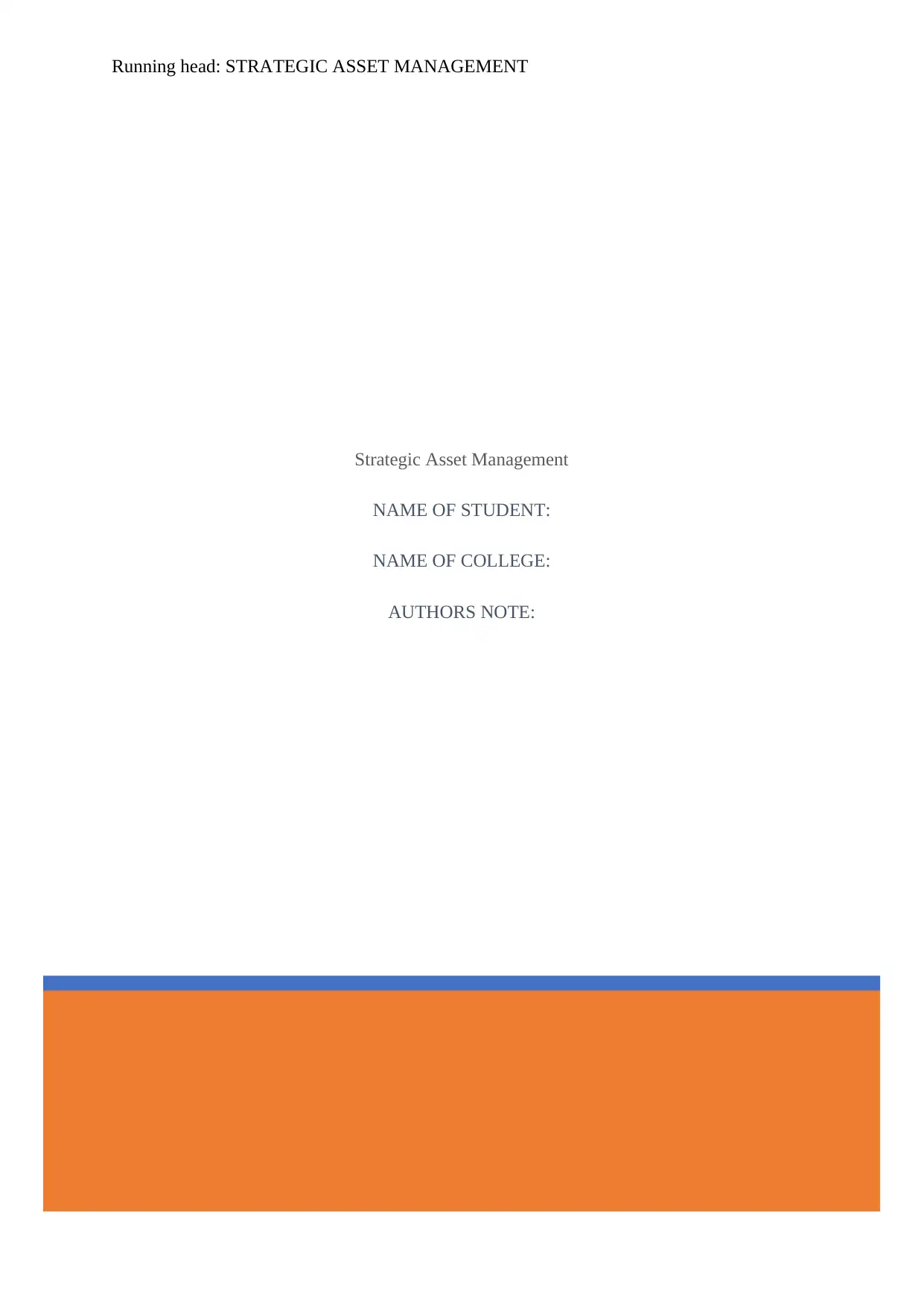
Strategic Asset Management
NAME OF STUDENT:
NAME OF COLLEGE:
AUTHORS NOTE:
Running head: STRATEGIC ASSET MANAGEMENT
NAME OF STUDENT:
NAME OF COLLEGE:
AUTHORS NOTE:
Running head: STRATEGIC ASSET MANAGEMENT
Paraphrase This Document
Need a fresh take? Get an instant paraphrase of this document with our AI Paraphraser
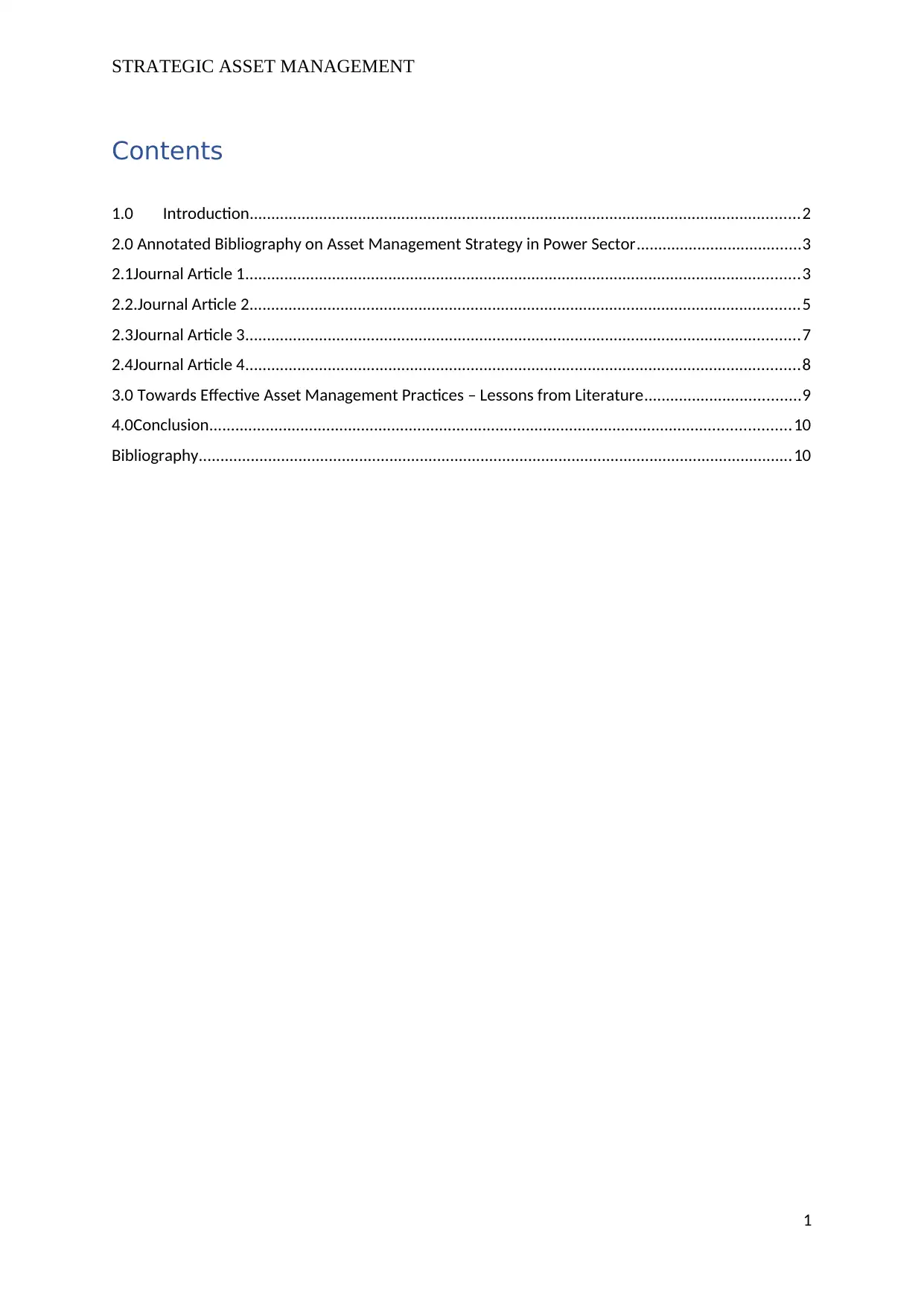
STRATEGIC ASSET MANAGEMENT
Contents
1.0 Introduction...............................................................................................................................2
2.0 Annotated Bibliography on Asset Management Strategy in Power Sector......................................3
2.1Journal Article 1................................................................................................................................3
2.2.Journal Article 2...............................................................................................................................5
2.3Journal Article 3................................................................................................................................7
2.4Journal Article 4................................................................................................................................8
3.0 Towards Effective Asset Management Practices – Lessons from Literature....................................9
4.0Conclusion......................................................................................................................................10
Bibliography.........................................................................................................................................10
1
Contents
1.0 Introduction...............................................................................................................................2
2.0 Annotated Bibliography on Asset Management Strategy in Power Sector......................................3
2.1Journal Article 1................................................................................................................................3
2.2.Journal Article 2...............................................................................................................................5
2.3Journal Article 3................................................................................................................................7
2.4Journal Article 4................................................................................................................................8
3.0 Towards Effective Asset Management Practices – Lessons from Literature....................................9
4.0Conclusion......................................................................................................................................10
Bibliography.........................................................................................................................................10
1
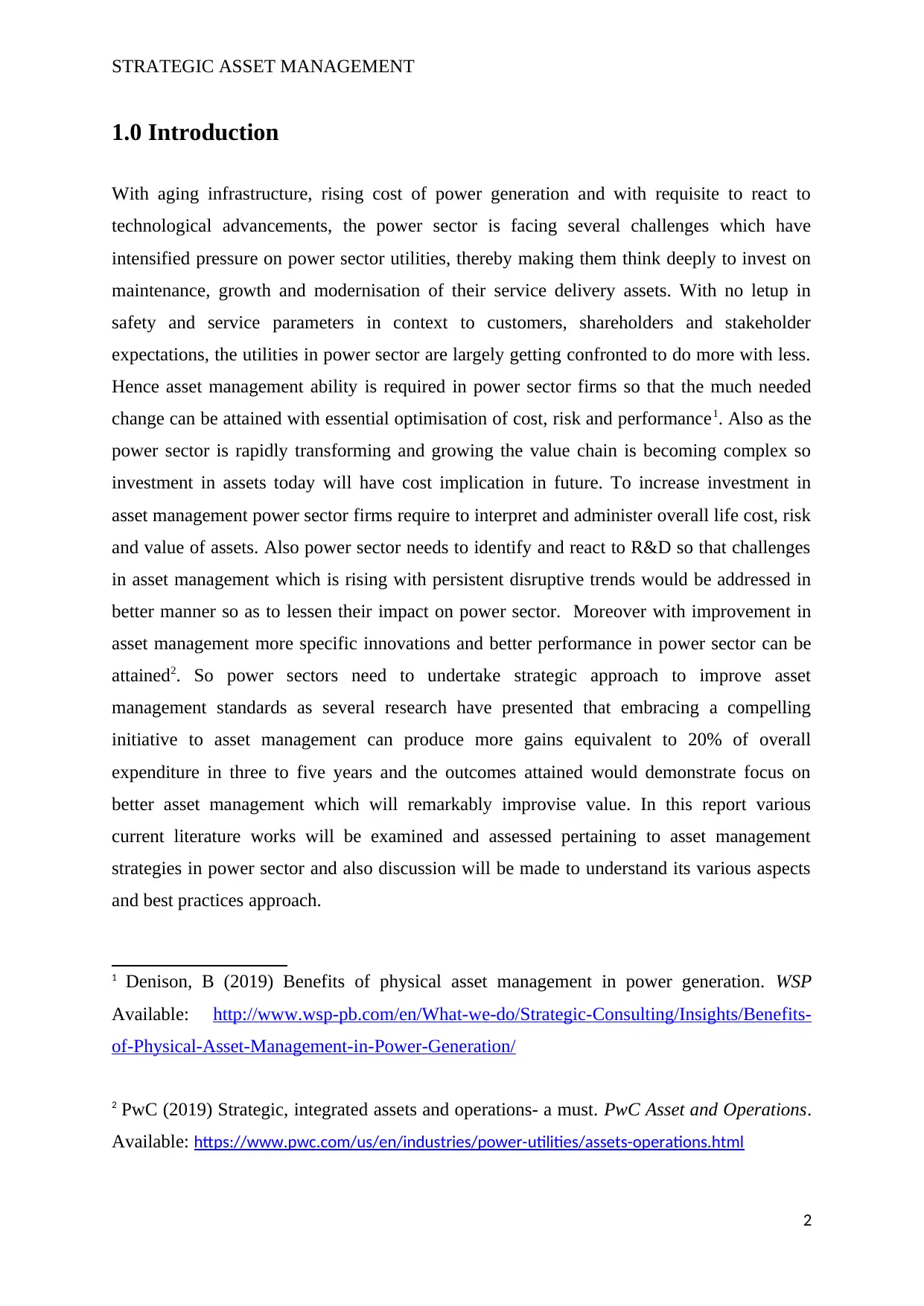
STRATEGIC ASSET MANAGEMENT
1.0 Introduction
With aging infrastructure, rising cost of power generation and with requisite to react to
technological advancements, the power sector is facing several challenges which have
intensified pressure on power sector utilities, thereby making them think deeply to invest on
maintenance, growth and modernisation of their service delivery assets. With no letup in
safety and service parameters in context to customers, shareholders and stakeholder
expectations, the utilities in power sector are largely getting confronted to do more with less.
Hence asset management ability is required in power sector firms so that the much needed
change can be attained with essential optimisation of cost, risk and performance1. Also as the
power sector is rapidly transforming and growing the value chain is becoming complex so
investment in assets today will have cost implication in future. To increase investment in
asset management power sector firms require to interpret and administer overall life cost, risk
and value of assets. Also power sector needs to identify and react to R&D so that challenges
in asset management which is rising with persistent disruptive trends would be addressed in
better manner so as to lessen their impact on power sector. Moreover with improvement in
asset management more specific innovations and better performance in power sector can be
attained2. So power sectors need to undertake strategic approach to improve asset
management standards as several research have presented that embracing a compelling
initiative to asset management can produce more gains equivalent to 20% of overall
expenditure in three to five years and the outcomes attained would demonstrate focus on
better asset management which will remarkably improvise value. In this report various
current literature works will be examined and assessed pertaining to asset management
strategies in power sector and also discussion will be made to understand its various aspects
and best practices approach.
1 Denison, B (2019) Benefits of physical asset management in power generation. WSP
Available: http://www.wsp-pb.com/en/What-we-do/Strategic-Consulting/Insights/Benefits-
of-Physical-Asset-Management-in-Power-Generation/
2 PwC (2019) Strategic, integrated assets and operations- a must. PwC Asset and Operations.
Available: https://www.pwc.com/us/en/industries/power-utilities/assets-operations.html
2
1.0 Introduction
With aging infrastructure, rising cost of power generation and with requisite to react to
technological advancements, the power sector is facing several challenges which have
intensified pressure on power sector utilities, thereby making them think deeply to invest on
maintenance, growth and modernisation of their service delivery assets. With no letup in
safety and service parameters in context to customers, shareholders and stakeholder
expectations, the utilities in power sector are largely getting confronted to do more with less.
Hence asset management ability is required in power sector firms so that the much needed
change can be attained with essential optimisation of cost, risk and performance1. Also as the
power sector is rapidly transforming and growing the value chain is becoming complex so
investment in assets today will have cost implication in future. To increase investment in
asset management power sector firms require to interpret and administer overall life cost, risk
and value of assets. Also power sector needs to identify and react to R&D so that challenges
in asset management which is rising with persistent disruptive trends would be addressed in
better manner so as to lessen their impact on power sector. Moreover with improvement in
asset management more specific innovations and better performance in power sector can be
attained2. So power sectors need to undertake strategic approach to improve asset
management standards as several research have presented that embracing a compelling
initiative to asset management can produce more gains equivalent to 20% of overall
expenditure in three to five years and the outcomes attained would demonstrate focus on
better asset management which will remarkably improvise value. In this report various
current literature works will be examined and assessed pertaining to asset management
strategies in power sector and also discussion will be made to understand its various aspects
and best practices approach.
1 Denison, B (2019) Benefits of physical asset management in power generation. WSP
Available: http://www.wsp-pb.com/en/What-we-do/Strategic-Consulting/Insights/Benefits-
of-Physical-Asset-Management-in-Power-Generation/
2 PwC (2019) Strategic, integrated assets and operations- a must. PwC Asset and Operations.
Available: https://www.pwc.com/us/en/industries/power-utilities/assets-operations.html
2
⊘ This is a preview!⊘
Do you want full access?
Subscribe today to unlock all pages.

Trusted by 1+ million students worldwide
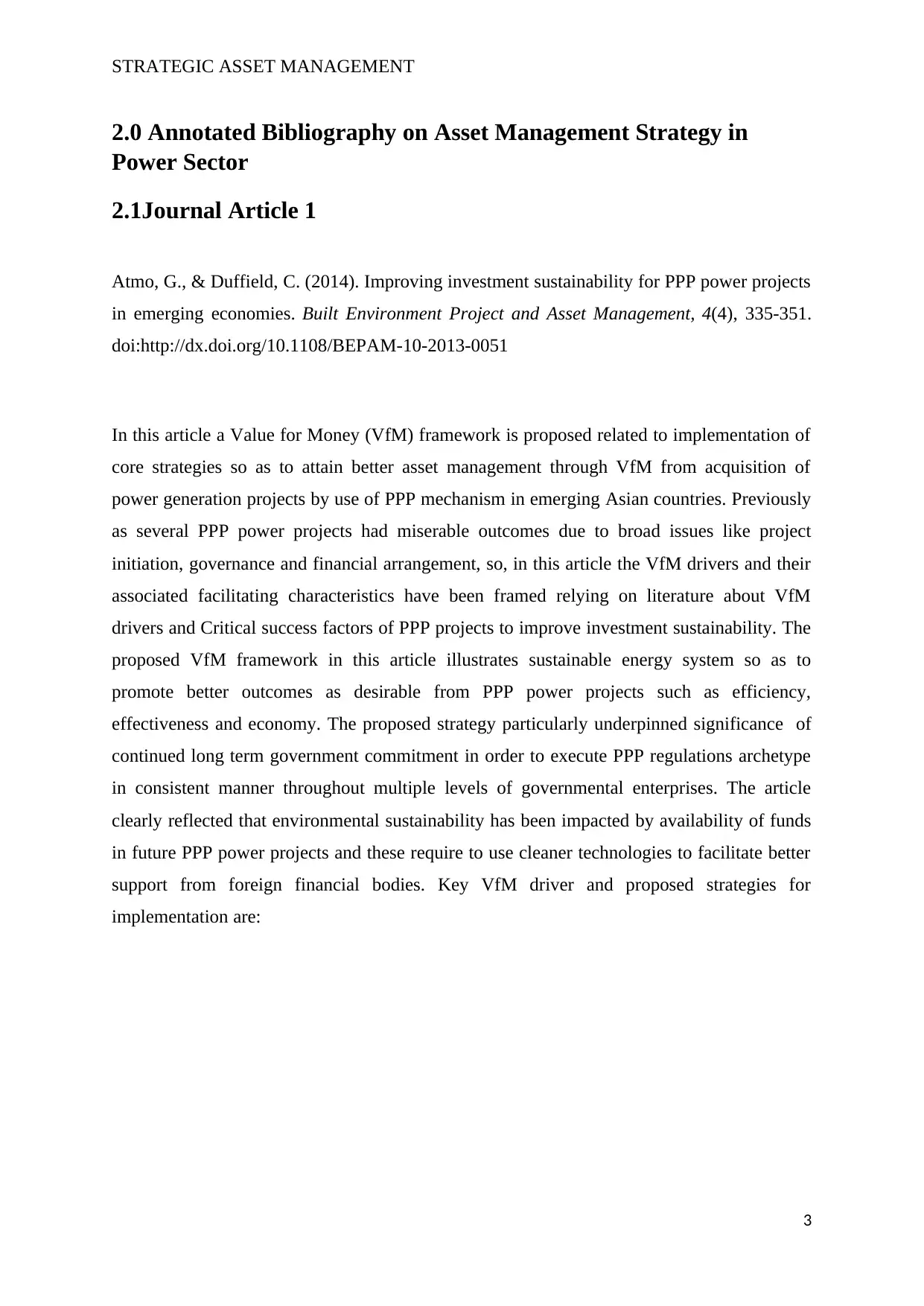
STRATEGIC ASSET MANAGEMENT
2.0 Annotated Bibliography on Asset Management Strategy in
Power Sector
2.1Journal Article 1
Atmo, G., & Duffield, C. (2014). Improving investment sustainability for PPP power projects
in emerging economies. Built Environment Project and Asset Management, 4(4), 335-351.
doi:http://dx.doi.org/10.1108/BEPAM-10-2013-0051
In this article a Value for Money (VfM) framework is proposed related to implementation of
core strategies so as to attain better asset management through VfM from acquisition of
power generation projects by use of PPP mechanism in emerging Asian countries. Previously
as several PPP power projects had miserable outcomes due to broad issues like project
initiation, governance and financial arrangement, so, in this article the VfM drivers and their
associated facilitating characteristics have been framed relying on literature about VfM
drivers and Critical success factors of PPP projects to improve investment sustainability. The
proposed VfM framework in this article illustrates sustainable energy system so as to
promote better outcomes as desirable from PPP power projects such as efficiency,
effectiveness and economy. The proposed strategy particularly underpinned significance of
continued long term government commitment in order to execute PPP regulations archetype
in consistent manner throughout multiple levels of governmental enterprises. The article
clearly reflected that environmental sustainability has been impacted by availability of funds
in future PPP power projects and these require to use cleaner technologies to facilitate better
support from foreign financial bodies. Key VfM driver and proposed strategies for
implementation are:
3
2.0 Annotated Bibliography on Asset Management Strategy in
Power Sector
2.1Journal Article 1
Atmo, G., & Duffield, C. (2014). Improving investment sustainability for PPP power projects
in emerging economies. Built Environment Project and Asset Management, 4(4), 335-351.
doi:http://dx.doi.org/10.1108/BEPAM-10-2013-0051
In this article a Value for Money (VfM) framework is proposed related to implementation of
core strategies so as to attain better asset management through VfM from acquisition of
power generation projects by use of PPP mechanism in emerging Asian countries. Previously
as several PPP power projects had miserable outcomes due to broad issues like project
initiation, governance and financial arrangement, so, in this article the VfM drivers and their
associated facilitating characteristics have been framed relying on literature about VfM
drivers and Critical success factors of PPP projects to improve investment sustainability. The
proposed VfM framework in this article illustrates sustainable energy system so as to
promote better outcomes as desirable from PPP power projects such as efficiency,
effectiveness and economy. The proposed strategy particularly underpinned significance of
continued long term government commitment in order to execute PPP regulations archetype
in consistent manner throughout multiple levels of governmental enterprises. The article
clearly reflected that environmental sustainability has been impacted by availability of funds
in future PPP power projects and these require to use cleaner technologies to facilitate better
support from foreign financial bodies. Key VfM driver and proposed strategies for
implementation are:
3
Paraphrase This Document
Need a fresh take? Get an instant paraphrase of this document with our AI Paraphraser
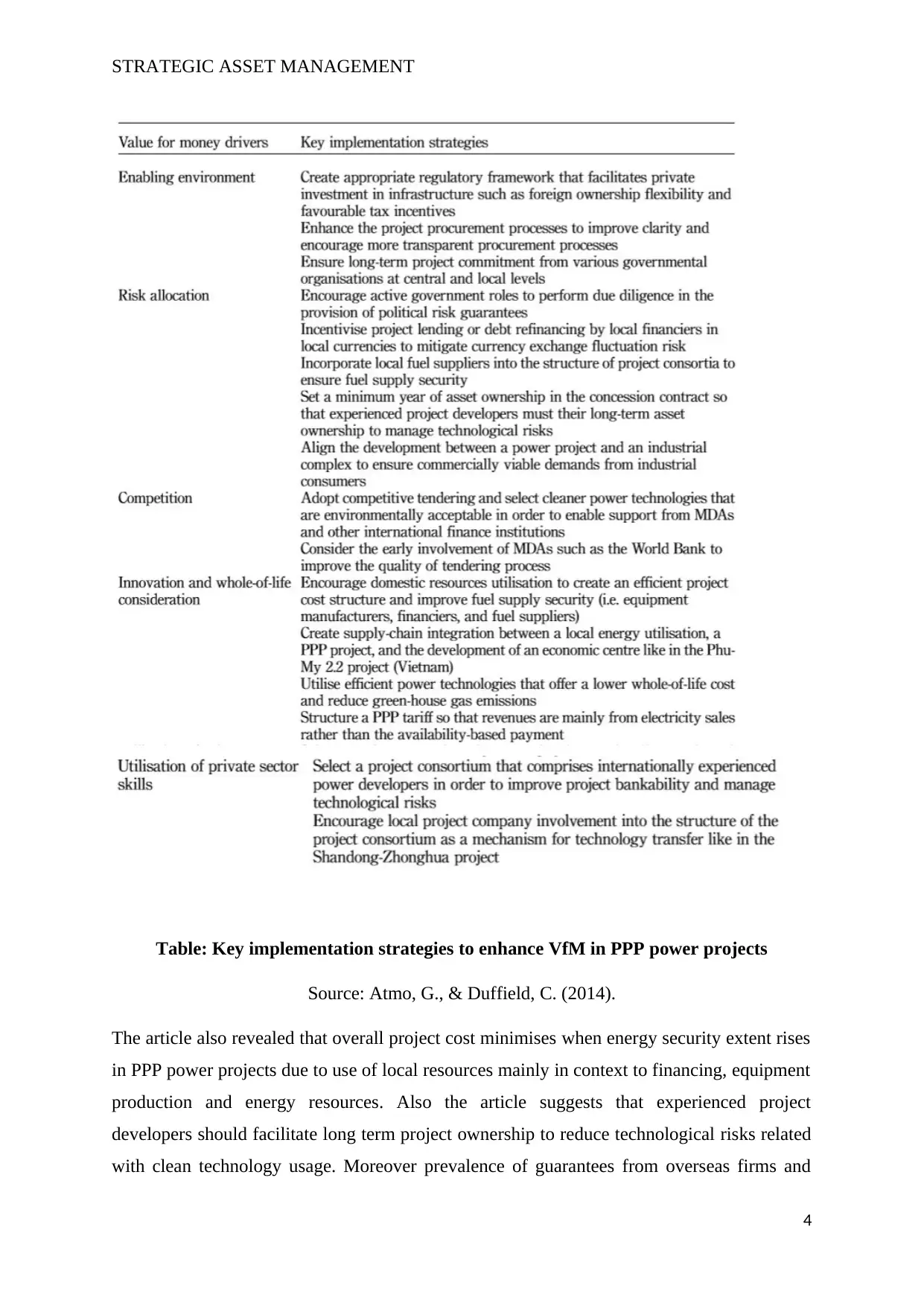
STRATEGIC ASSET MANAGEMENT
Table: Key implementation strategies to enhance VfM in PPP power projects
Source: Atmo, G., & Duffield, C. (2014).
The article also revealed that overall project cost minimises when energy security extent rises
in PPP power projects due to use of local resources mainly in context to financing, equipment
production and energy resources. Also the article suggests that experienced project
developers should facilitate long term project ownership to reduce technological risks related
with clean technology usage. Moreover prevalence of guarantees from overseas firms and
4
Table: Key implementation strategies to enhance VfM in PPP power projects
Source: Atmo, G., & Duffield, C. (2014).
The article also revealed that overall project cost minimises when energy security extent rises
in PPP power projects due to use of local resources mainly in context to financing, equipment
production and energy resources. Also the article suggests that experienced project
developers should facilitate long term project ownership to reduce technological risks related
with clean technology usage. Moreover prevalence of guarantees from overseas firms and
4
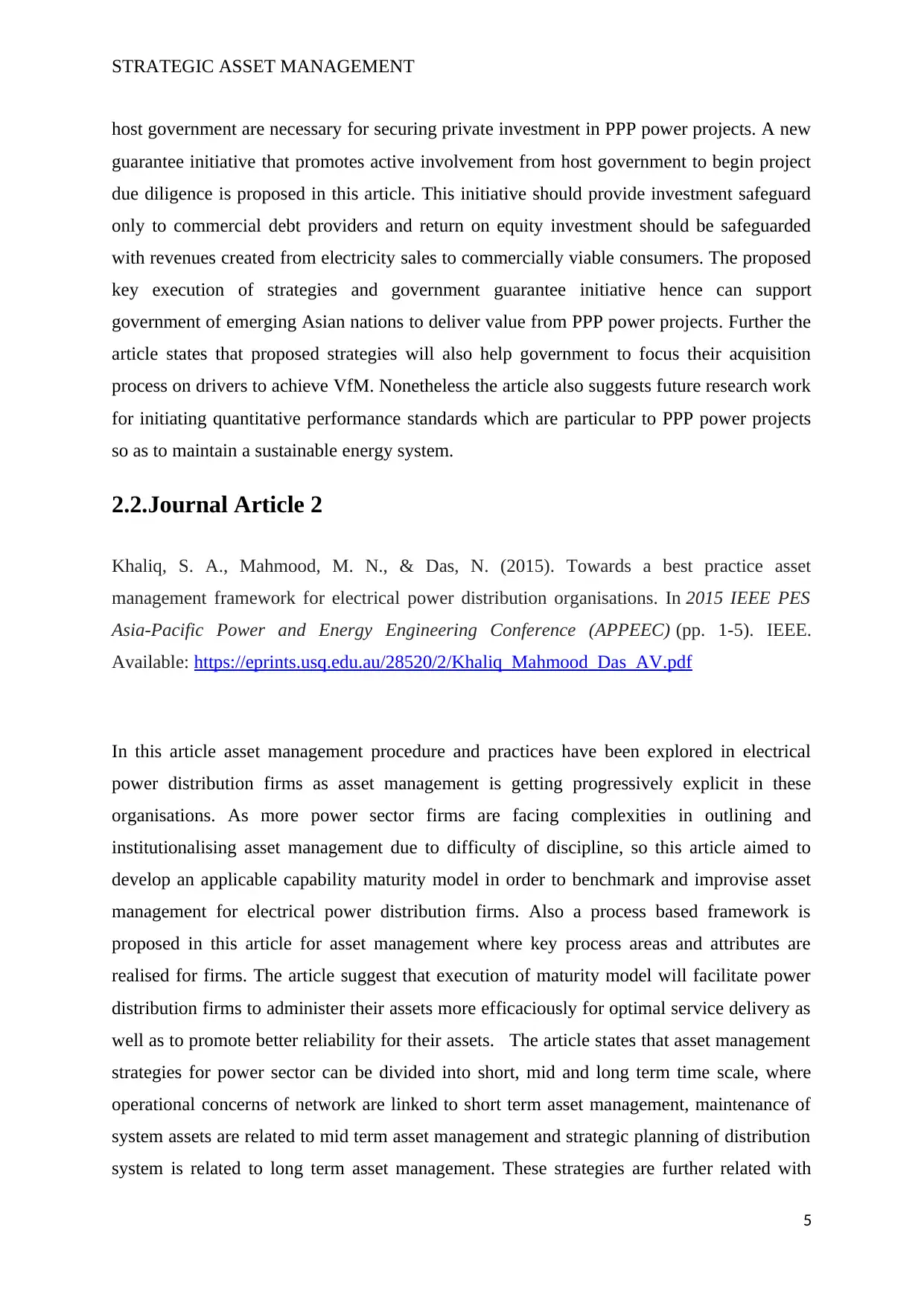
STRATEGIC ASSET MANAGEMENT
host government are necessary for securing private investment in PPP power projects. A new
guarantee initiative that promotes active involvement from host government to begin project
due diligence is proposed in this article. This initiative should provide investment safeguard
only to commercial debt providers and return on equity investment should be safeguarded
with revenues created from electricity sales to commercially viable consumers. The proposed
key execution of strategies and government guarantee initiative hence can support
government of emerging Asian nations to deliver value from PPP power projects. Further the
article states that proposed strategies will also help government to focus their acquisition
process on drivers to achieve VfM. Nonetheless the article also suggests future research work
for initiating quantitative performance standards which are particular to PPP power projects
so as to maintain a sustainable energy system.
2.2.Journal Article 2
Khaliq, S. A., Mahmood, M. N., & Das, N. (2015). Towards a best practice asset
management framework for electrical power distribution organisations. In 2015 IEEE PES
Asia-Pacific Power and Energy Engineering Conference (APPEEC) (pp. 1-5). IEEE.
Available: https://eprints.usq.edu.au/28520/2/Khaliq_Mahmood_Das_AV.pdf
In this article asset management procedure and practices have been explored in electrical
power distribution firms as asset management is getting progressively explicit in these
organisations. As more power sector firms are facing complexities in outlining and
institutionalising asset management due to difficulty of discipline, so this article aimed to
develop an applicable capability maturity model in order to benchmark and improvise asset
management for electrical power distribution firms. Also a process based framework is
proposed in this article for asset management where key process areas and attributes are
realised for firms. The article suggest that execution of maturity model will facilitate power
distribution firms to administer their assets more efficaciously for optimal service delivery as
well as to promote better reliability for their assets. The article states that asset management
strategies for power sector can be divided into short, mid and long term time scale, where
operational concerns of network are linked to short term asset management, maintenance of
system assets are related to mid term asset management and strategic planning of distribution
system is related to long term asset management. These strategies are further related with
5
host government are necessary for securing private investment in PPP power projects. A new
guarantee initiative that promotes active involvement from host government to begin project
due diligence is proposed in this article. This initiative should provide investment safeguard
only to commercial debt providers and return on equity investment should be safeguarded
with revenues created from electricity sales to commercially viable consumers. The proposed
key execution of strategies and government guarantee initiative hence can support
government of emerging Asian nations to deliver value from PPP power projects. Further the
article states that proposed strategies will also help government to focus their acquisition
process on drivers to achieve VfM. Nonetheless the article also suggests future research work
for initiating quantitative performance standards which are particular to PPP power projects
so as to maintain a sustainable energy system.
2.2.Journal Article 2
Khaliq, S. A., Mahmood, M. N., & Das, N. (2015). Towards a best practice asset
management framework for electrical power distribution organisations. In 2015 IEEE PES
Asia-Pacific Power and Energy Engineering Conference (APPEEC) (pp. 1-5). IEEE.
Available: https://eprints.usq.edu.au/28520/2/Khaliq_Mahmood_Das_AV.pdf
In this article asset management procedure and practices have been explored in electrical
power distribution firms as asset management is getting progressively explicit in these
organisations. As more power sector firms are facing complexities in outlining and
institutionalising asset management due to difficulty of discipline, so this article aimed to
develop an applicable capability maturity model in order to benchmark and improvise asset
management for electrical power distribution firms. Also a process based framework is
proposed in this article for asset management where key process areas and attributes are
realised for firms. The article suggest that execution of maturity model will facilitate power
distribution firms to administer their assets more efficaciously for optimal service delivery as
well as to promote better reliability for their assets. The article states that asset management
strategies for power sector can be divided into short, mid and long term time scale, where
operational concerns of network are linked to short term asset management, maintenance of
system assets are related to mid term asset management and strategic planning of distribution
system is related to long term asset management. These strategies are further related with
5
⊘ This is a preview!⊘
Do you want full access?
Subscribe today to unlock all pages.

Trusted by 1+ million students worldwide
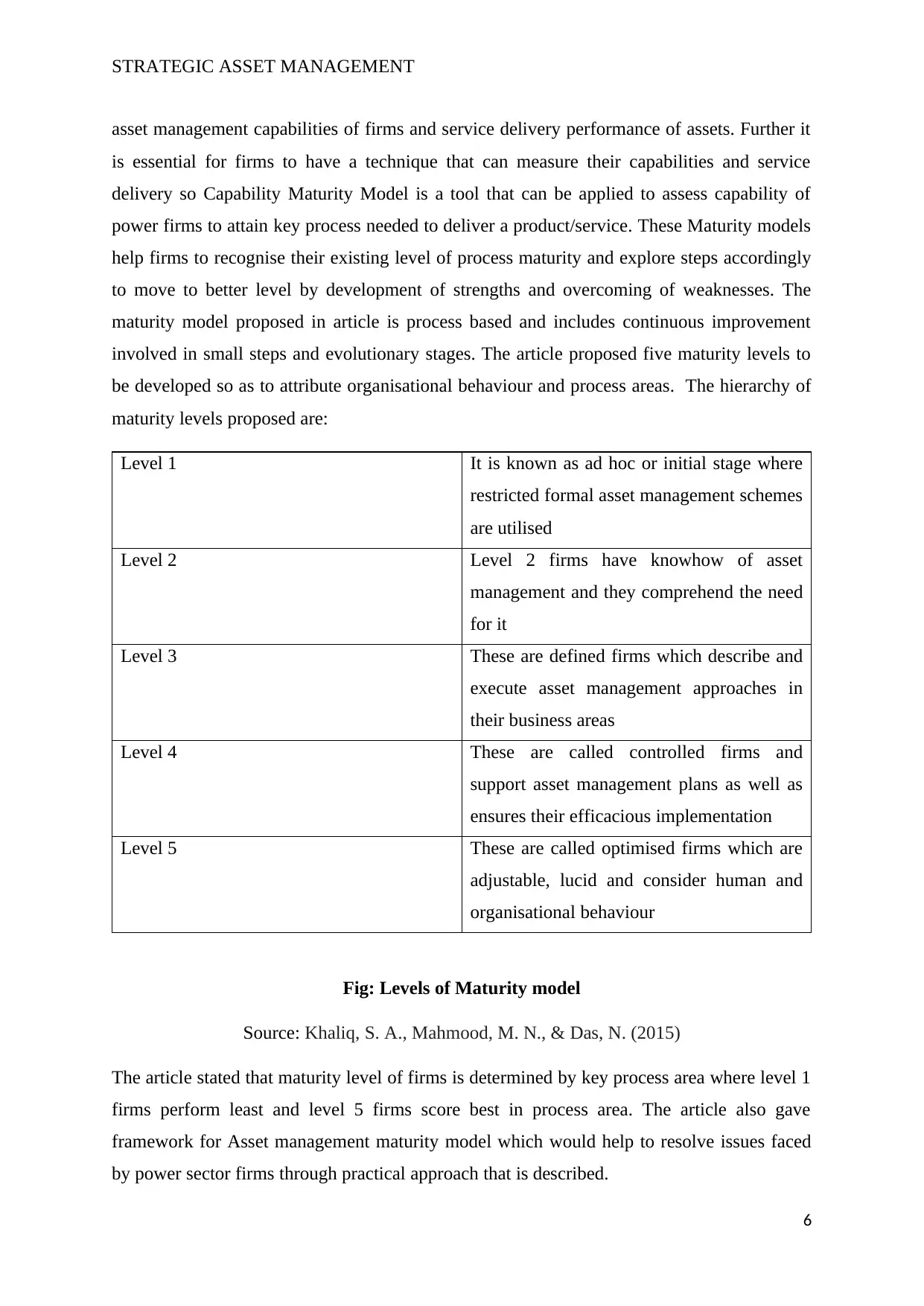
STRATEGIC ASSET MANAGEMENT
asset management capabilities of firms and service delivery performance of assets. Further it
is essential for firms to have a technique that can measure their capabilities and service
delivery so Capability Maturity Model is a tool that can be applied to assess capability of
power firms to attain key process needed to deliver a product/service. These Maturity models
help firms to recognise their existing level of process maturity and explore steps accordingly
to move to better level by development of strengths and overcoming of weaknesses. The
maturity model proposed in article is process based and includes continuous improvement
involved in small steps and evolutionary stages. The article proposed five maturity levels to
be developed so as to attribute organisational behaviour and process areas. The hierarchy of
maturity levels proposed are:
Level 1 It is known as ad hoc or initial stage where
restricted formal asset management schemes
are utilised
Level 2 Level 2 firms have knowhow of asset
management and they comprehend the need
for it
Level 3 These are defined firms which describe and
execute asset management approaches in
their business areas
Level 4 These are called controlled firms and
support asset management plans as well as
ensures their efficacious implementation
Level 5 These are called optimised firms which are
adjustable, lucid and consider human and
organisational behaviour
Fig: Levels of Maturity model
Source: Khaliq, S. A., Mahmood, M. N., & Das, N. (2015)
The article stated that maturity level of firms is determined by key process area where level 1
firms perform least and level 5 firms score best in process area. The article also gave
framework for Asset management maturity model which would help to resolve issues faced
by power sector firms through practical approach that is described.
6
asset management capabilities of firms and service delivery performance of assets. Further it
is essential for firms to have a technique that can measure their capabilities and service
delivery so Capability Maturity Model is a tool that can be applied to assess capability of
power firms to attain key process needed to deliver a product/service. These Maturity models
help firms to recognise their existing level of process maturity and explore steps accordingly
to move to better level by development of strengths and overcoming of weaknesses. The
maturity model proposed in article is process based and includes continuous improvement
involved in small steps and evolutionary stages. The article proposed five maturity levels to
be developed so as to attribute organisational behaviour and process areas. The hierarchy of
maturity levels proposed are:
Level 1 It is known as ad hoc or initial stage where
restricted formal asset management schemes
are utilised
Level 2 Level 2 firms have knowhow of asset
management and they comprehend the need
for it
Level 3 These are defined firms which describe and
execute asset management approaches in
their business areas
Level 4 These are called controlled firms and
support asset management plans as well as
ensures their efficacious implementation
Level 5 These are called optimised firms which are
adjustable, lucid and consider human and
organisational behaviour
Fig: Levels of Maturity model
Source: Khaliq, S. A., Mahmood, M. N., & Das, N. (2015)
The article stated that maturity level of firms is determined by key process area where level 1
firms perform least and level 5 firms score best in process area. The article also gave
framework for Asset management maturity model which would help to resolve issues faced
by power sector firms through practical approach that is described.
6
Paraphrase This Document
Need a fresh take? Get an instant paraphrase of this document with our AI Paraphraser
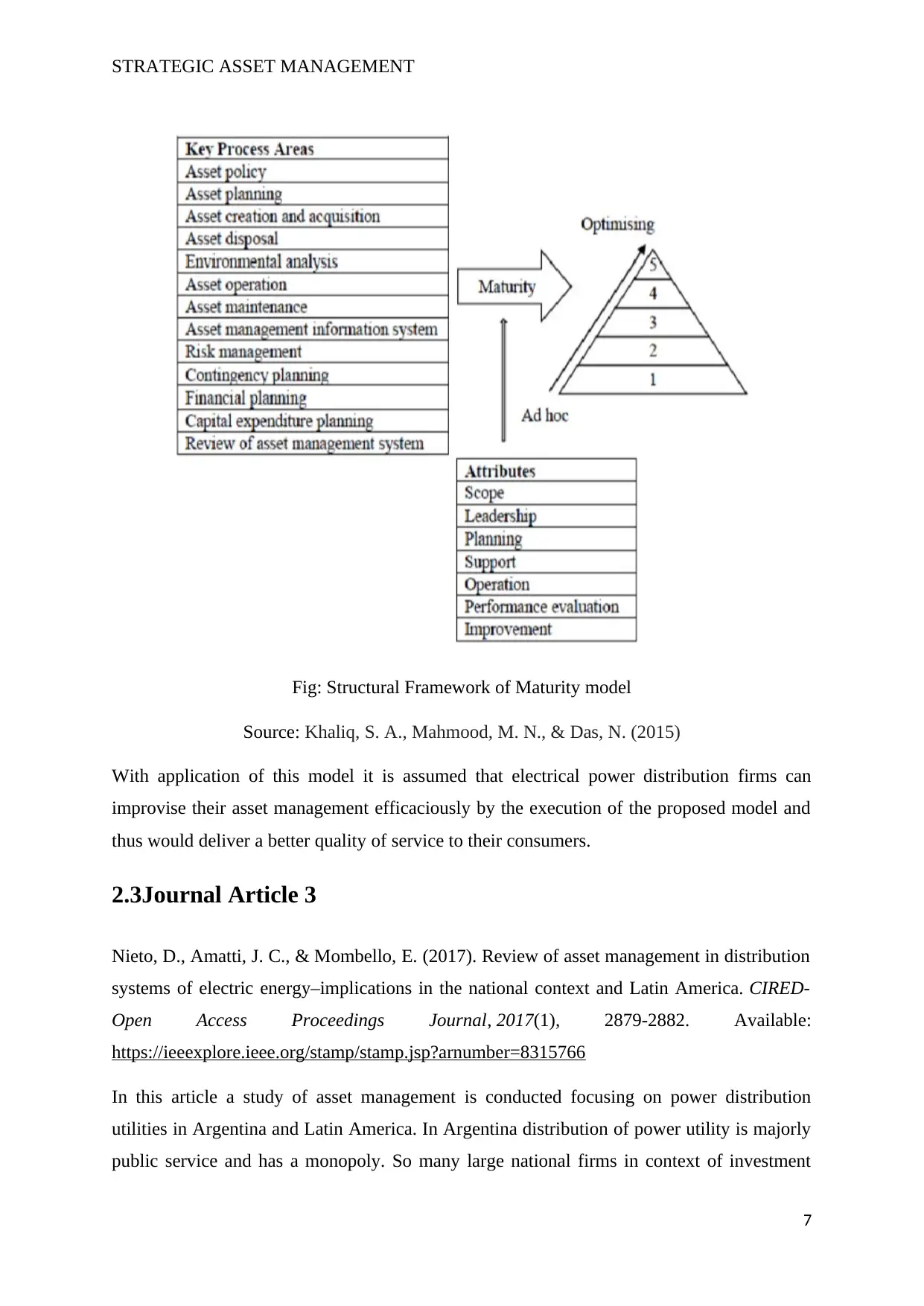
STRATEGIC ASSET MANAGEMENT
Fig: Structural Framework of Maturity model
Source: Khaliq, S. A., Mahmood, M. N., & Das, N. (2015)
With application of this model it is assumed that electrical power distribution firms can
improvise their asset management efficaciously by the execution of the proposed model and
thus would deliver a better quality of service to their consumers.
2.3Journal Article 3
Nieto, D., Amatti, J. C., & Mombello, E. (2017). Review of asset management in distribution
systems of electric energy–implications in the national context and Latin America. CIRED-
Open Access Proceedings Journal, 2017(1), 2879-2882. Available:
https://ieeexplore.ieee.org/stamp/stamp.jsp?arnumber=8315766
In this article a study of asset management is conducted focusing on power distribution
utilities in Argentina and Latin America. In Argentina distribution of power utility is majorly
public service and has a monopoly. So many large national firms in context of investment
7
Fig: Structural Framework of Maturity model
Source: Khaliq, S. A., Mahmood, M. N., & Das, N. (2015)
With application of this model it is assumed that electrical power distribution firms can
improvise their asset management efficaciously by the execution of the proposed model and
thus would deliver a better quality of service to their consumers.
2.3Journal Article 3
Nieto, D., Amatti, J. C., & Mombello, E. (2017). Review of asset management in distribution
systems of electric energy–implications in the national context and Latin America. CIRED-
Open Access Proceedings Journal, 2017(1), 2879-2882. Available:
https://ieeexplore.ieee.org/stamp/stamp.jsp?arnumber=8315766
In this article a study of asset management is conducted focusing on power distribution
utilities in Argentina and Latin America. In Argentina distribution of power utility is majorly
public service and has a monopoly. So many large national firms in context of investment
7
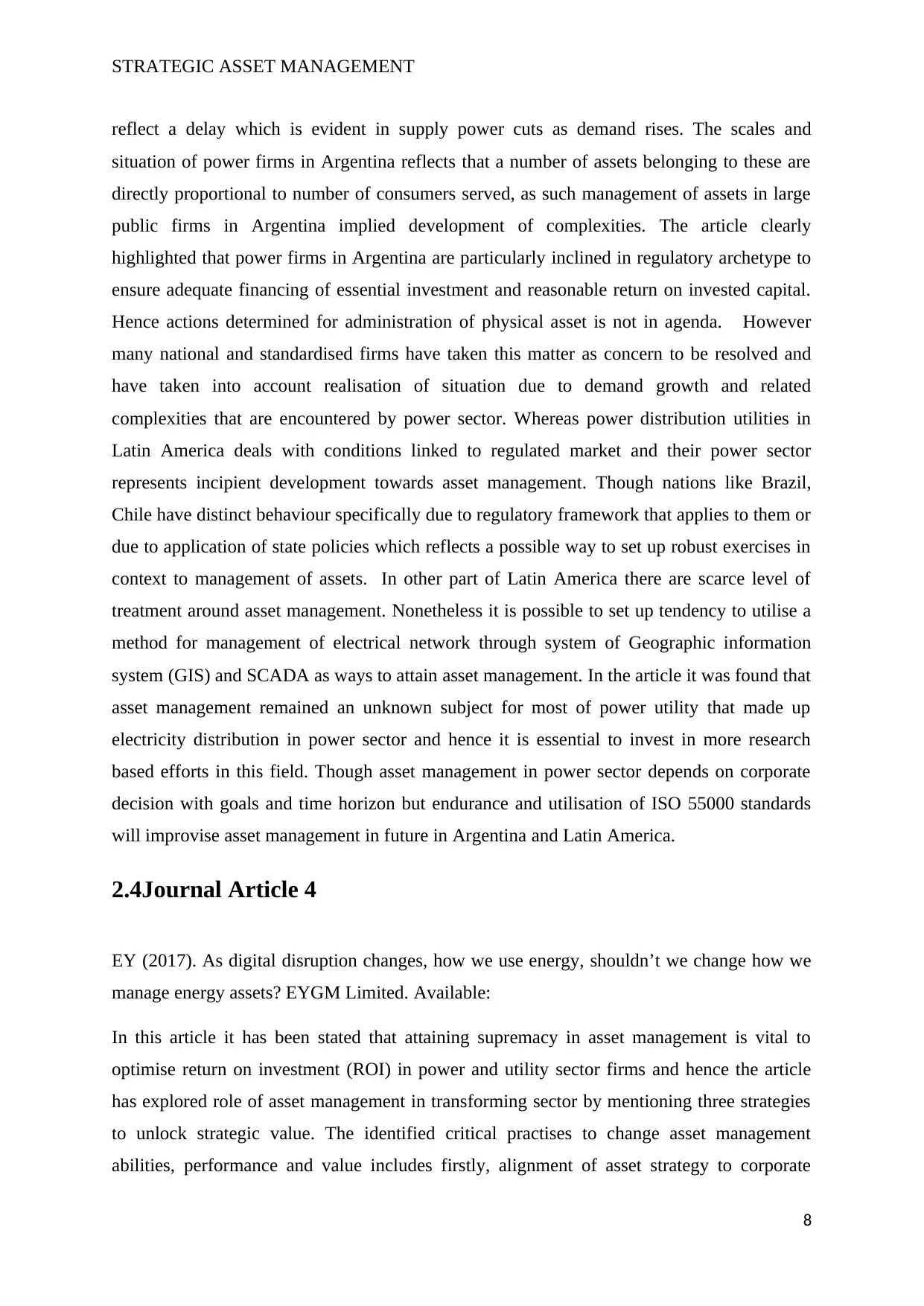
STRATEGIC ASSET MANAGEMENT
reflect a delay which is evident in supply power cuts as demand rises. The scales and
situation of power firms in Argentina reflects that a number of assets belonging to these are
directly proportional to number of consumers served, as such management of assets in large
public firms in Argentina implied development of complexities. The article clearly
highlighted that power firms in Argentina are particularly inclined in regulatory archetype to
ensure adequate financing of essential investment and reasonable return on invested capital.
Hence actions determined for administration of physical asset is not in agenda. However
many national and standardised firms have taken this matter as concern to be resolved and
have taken into account realisation of situation due to demand growth and related
complexities that are encountered by power sector. Whereas power distribution utilities in
Latin America deals with conditions linked to regulated market and their power sector
represents incipient development towards asset management. Though nations like Brazil,
Chile have distinct behaviour specifically due to regulatory framework that applies to them or
due to application of state policies which reflects a possible way to set up robust exercises in
context to management of assets. In other part of Latin America there are scarce level of
treatment around asset management. Nonetheless it is possible to set up tendency to utilise a
method for management of electrical network through system of Geographic information
system (GIS) and SCADA as ways to attain asset management. In the article it was found that
asset management remained an unknown subject for most of power utility that made up
electricity distribution in power sector and hence it is essential to invest in more research
based efforts in this field. Though asset management in power sector depends on corporate
decision with goals and time horizon but endurance and utilisation of ISO 55000 standards
will improvise asset management in future in Argentina and Latin America.
2.4Journal Article 4
EY (2017). As digital disruption changes, how we use energy, shouldn’t we change how we
manage energy assets? EYGM Limited. Available:
In this article it has been stated that attaining supremacy in asset management is vital to
optimise return on investment (ROI) in power and utility sector firms and hence the article
has explored role of asset management in transforming sector by mentioning three strategies
to unlock strategic value. The identified critical practises to change asset management
abilities, performance and value includes firstly, alignment of asset strategy to corporate
8
reflect a delay which is evident in supply power cuts as demand rises. The scales and
situation of power firms in Argentina reflects that a number of assets belonging to these are
directly proportional to number of consumers served, as such management of assets in large
public firms in Argentina implied development of complexities. The article clearly
highlighted that power firms in Argentina are particularly inclined in regulatory archetype to
ensure adequate financing of essential investment and reasonable return on invested capital.
Hence actions determined for administration of physical asset is not in agenda. However
many national and standardised firms have taken this matter as concern to be resolved and
have taken into account realisation of situation due to demand growth and related
complexities that are encountered by power sector. Whereas power distribution utilities in
Latin America deals with conditions linked to regulated market and their power sector
represents incipient development towards asset management. Though nations like Brazil,
Chile have distinct behaviour specifically due to regulatory framework that applies to them or
due to application of state policies which reflects a possible way to set up robust exercises in
context to management of assets. In other part of Latin America there are scarce level of
treatment around asset management. Nonetheless it is possible to set up tendency to utilise a
method for management of electrical network through system of Geographic information
system (GIS) and SCADA as ways to attain asset management. In the article it was found that
asset management remained an unknown subject for most of power utility that made up
electricity distribution in power sector and hence it is essential to invest in more research
based efforts in this field. Though asset management in power sector depends on corporate
decision with goals and time horizon but endurance and utilisation of ISO 55000 standards
will improvise asset management in future in Argentina and Latin America.
2.4Journal Article 4
EY (2017). As digital disruption changes, how we use energy, shouldn’t we change how we
manage energy assets? EYGM Limited. Available:
In this article it has been stated that attaining supremacy in asset management is vital to
optimise return on investment (ROI) in power and utility sector firms and hence the article
has explored role of asset management in transforming sector by mentioning three strategies
to unlock strategic value. The identified critical practises to change asset management
abilities, performance and value includes firstly, alignment of asset strategy to corporate
8
⊘ This is a preview!⊘
Do you want full access?
Subscribe today to unlock all pages.

Trusted by 1+ million students worldwide
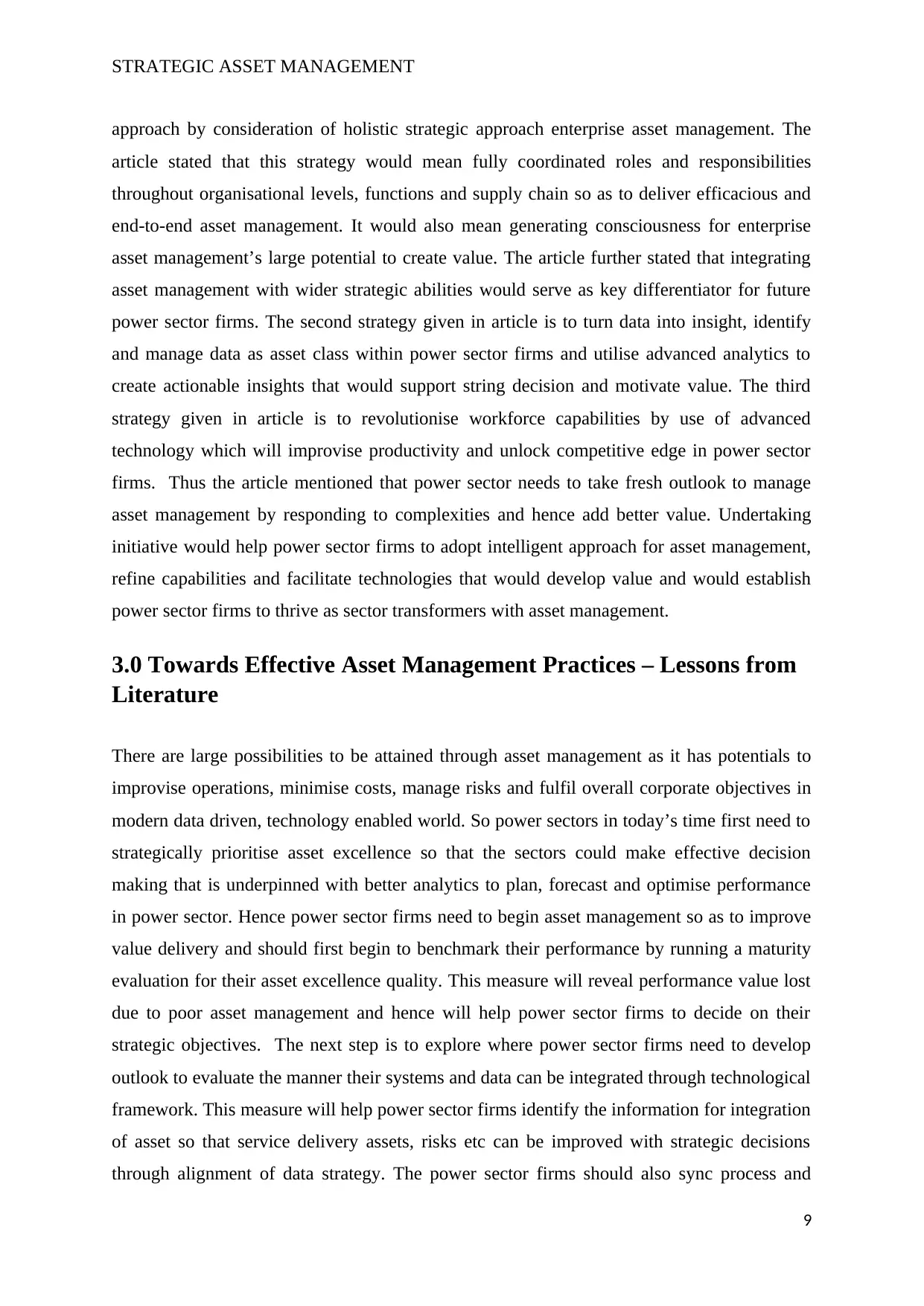
STRATEGIC ASSET MANAGEMENT
approach by consideration of holistic strategic approach enterprise asset management. The
article stated that this strategy would mean fully coordinated roles and responsibilities
throughout organisational levels, functions and supply chain so as to deliver efficacious and
end-to-end asset management. It would also mean generating consciousness for enterprise
asset management’s large potential to create value. The article further stated that integrating
asset management with wider strategic abilities would serve as key differentiator for future
power sector firms. The second strategy given in article is to turn data into insight, identify
and manage data as asset class within power sector firms and utilise advanced analytics to
create actionable insights that would support string decision and motivate value. The third
strategy given in article is to revolutionise workforce capabilities by use of advanced
technology which will improvise productivity and unlock competitive edge in power sector
firms. Thus the article mentioned that power sector needs to take fresh outlook to manage
asset management by responding to complexities and hence add better value. Undertaking
initiative would help power sector firms to adopt intelligent approach for asset management,
refine capabilities and facilitate technologies that would develop value and would establish
power sector firms to thrive as sector transformers with asset management.
3.0 Towards Effective Asset Management Practices – Lessons from
Literature
There are large possibilities to be attained through asset management as it has potentials to
improvise operations, minimise costs, manage risks and fulfil overall corporate objectives in
modern data driven, technology enabled world. So power sectors in today’s time first need to
strategically prioritise asset excellence so that the sectors could make effective decision
making that is underpinned with better analytics to plan, forecast and optimise performance
in power sector. Hence power sector firms need to begin asset management so as to improve
value delivery and should first begin to benchmark their performance by running a maturity
evaluation for their asset excellence quality. This measure will reveal performance value lost
due to poor asset management and hence will help power sector firms to decide on their
strategic objectives. The next step is to explore where power sector firms need to develop
outlook to evaluate the manner their systems and data can be integrated through technological
framework. This measure will help power sector firms identify the information for integration
of asset so that service delivery assets, risks etc can be improved with strategic decisions
through alignment of data strategy. The power sector firms should also sync process and
9
approach by consideration of holistic strategic approach enterprise asset management. The
article stated that this strategy would mean fully coordinated roles and responsibilities
throughout organisational levels, functions and supply chain so as to deliver efficacious and
end-to-end asset management. It would also mean generating consciousness for enterprise
asset management’s large potential to create value. The article further stated that integrating
asset management with wider strategic abilities would serve as key differentiator for future
power sector firms. The second strategy given in article is to turn data into insight, identify
and manage data as asset class within power sector firms and utilise advanced analytics to
create actionable insights that would support string decision and motivate value. The third
strategy given in article is to revolutionise workforce capabilities by use of advanced
technology which will improvise productivity and unlock competitive edge in power sector
firms. Thus the article mentioned that power sector needs to take fresh outlook to manage
asset management by responding to complexities and hence add better value. Undertaking
initiative would help power sector firms to adopt intelligent approach for asset management,
refine capabilities and facilitate technologies that would develop value and would establish
power sector firms to thrive as sector transformers with asset management.
3.0 Towards Effective Asset Management Practices – Lessons from
Literature
There are large possibilities to be attained through asset management as it has potentials to
improvise operations, minimise costs, manage risks and fulfil overall corporate objectives in
modern data driven, technology enabled world. So power sectors in today’s time first need to
strategically prioritise asset excellence so that the sectors could make effective decision
making that is underpinned with better analytics to plan, forecast and optimise performance
in power sector. Hence power sector firms need to begin asset management so as to improve
value delivery and should first begin to benchmark their performance by running a maturity
evaluation for their asset excellence quality. This measure will reveal performance value lost
due to poor asset management and hence will help power sector firms to decide on their
strategic objectives. The next step is to explore where power sector firms need to develop
outlook to evaluate the manner their systems and data can be integrated through technological
framework. This measure will help power sector firms identify the information for integration
of asset so that service delivery assets, risks etc can be improved with strategic decisions
through alignment of data strategy. The power sector firms should also sync process and
9
Paraphrase This Document
Need a fresh take? Get an instant paraphrase of this document with our AI Paraphraser
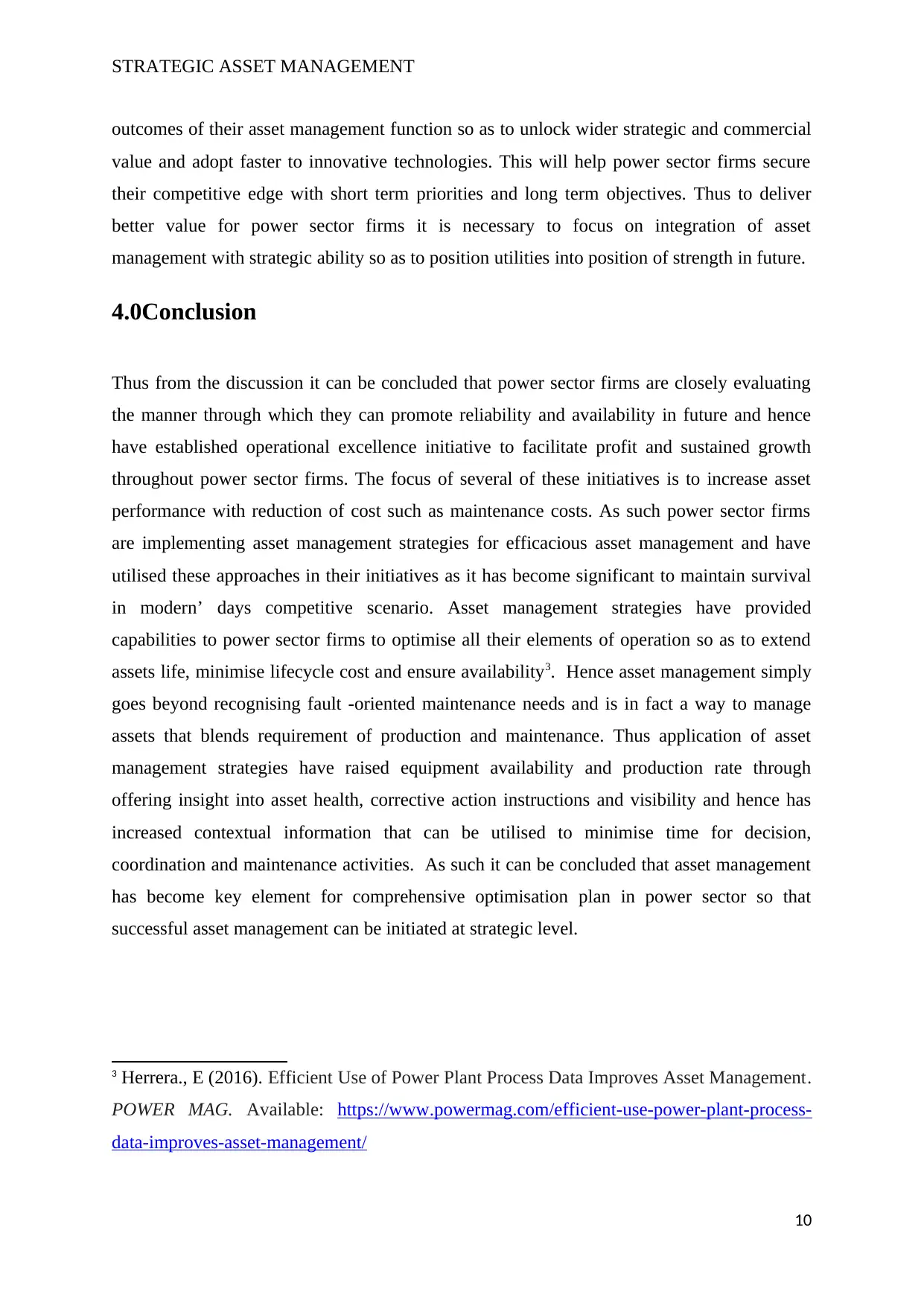
STRATEGIC ASSET MANAGEMENT
outcomes of their asset management function so as to unlock wider strategic and commercial
value and adopt faster to innovative technologies. This will help power sector firms secure
their competitive edge with short term priorities and long term objectives. Thus to deliver
better value for power sector firms it is necessary to focus on integration of asset
management with strategic ability so as to position utilities into position of strength in future.
4.0Conclusion
Thus from the discussion it can be concluded that power sector firms are closely evaluating
the manner through which they can promote reliability and availability in future and hence
have established operational excellence initiative to facilitate profit and sustained growth
throughout power sector firms. The focus of several of these initiatives is to increase asset
performance with reduction of cost such as maintenance costs. As such power sector firms
are implementing asset management strategies for efficacious asset management and have
utilised these approaches in their initiatives as it has become significant to maintain survival
in modern’ days competitive scenario. Asset management strategies have provided
capabilities to power sector firms to optimise all their elements of operation so as to extend
assets life, minimise lifecycle cost and ensure availability3. Hence asset management simply
goes beyond recognising fault -oriented maintenance needs and is in fact a way to manage
assets that blends requirement of production and maintenance. Thus application of asset
management strategies have raised equipment availability and production rate through
offering insight into asset health, corrective action instructions and visibility and hence has
increased contextual information that can be utilised to minimise time for decision,
coordination and maintenance activities. As such it can be concluded that asset management
has become key element for comprehensive optimisation plan in power sector so that
successful asset management can be initiated at strategic level.
3 Herrera., E (2016). Efficient Use of Power Plant Process Data Improves Asset Management.
POWER MAG. Available: https://www.powermag.com/efficient-use-power-plant-process-
data-improves-asset-management/
10
outcomes of their asset management function so as to unlock wider strategic and commercial
value and adopt faster to innovative technologies. This will help power sector firms secure
their competitive edge with short term priorities and long term objectives. Thus to deliver
better value for power sector firms it is necessary to focus on integration of asset
management with strategic ability so as to position utilities into position of strength in future.
4.0Conclusion
Thus from the discussion it can be concluded that power sector firms are closely evaluating
the manner through which they can promote reliability and availability in future and hence
have established operational excellence initiative to facilitate profit and sustained growth
throughout power sector firms. The focus of several of these initiatives is to increase asset
performance with reduction of cost such as maintenance costs. As such power sector firms
are implementing asset management strategies for efficacious asset management and have
utilised these approaches in their initiatives as it has become significant to maintain survival
in modern’ days competitive scenario. Asset management strategies have provided
capabilities to power sector firms to optimise all their elements of operation so as to extend
assets life, minimise lifecycle cost and ensure availability3. Hence asset management simply
goes beyond recognising fault -oriented maintenance needs and is in fact a way to manage
assets that blends requirement of production and maintenance. Thus application of asset
management strategies have raised equipment availability and production rate through
offering insight into asset health, corrective action instructions and visibility and hence has
increased contextual information that can be utilised to minimise time for decision,
coordination and maintenance activities. As such it can be concluded that asset management
has become key element for comprehensive optimisation plan in power sector so that
successful asset management can be initiated at strategic level.
3 Herrera., E (2016). Efficient Use of Power Plant Process Data Improves Asset Management.
POWER MAG. Available: https://www.powermag.com/efficient-use-power-plant-process-
data-improves-asset-management/
10
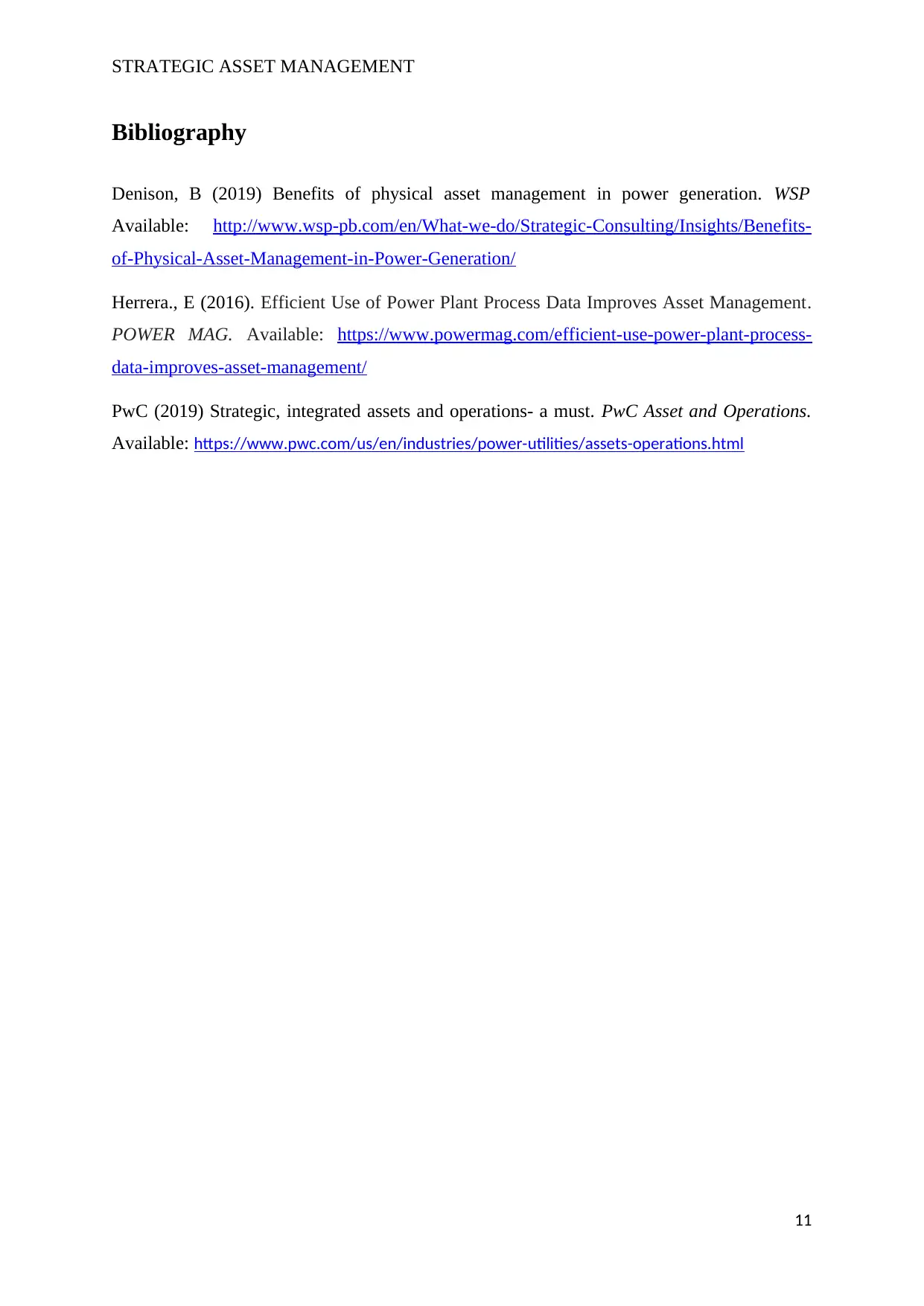
STRATEGIC ASSET MANAGEMENT
Bibliography
Denison, B (2019) Benefits of physical asset management in power generation. WSP
Available: http://www.wsp-pb.com/en/What-we-do/Strategic-Consulting/Insights/Benefits-
of-Physical-Asset-Management-in-Power-Generation/
Herrera., E (2016). Efficient Use of Power Plant Process Data Improves Asset Management.
POWER MAG. Available: https://www.powermag.com/efficient-use-power-plant-process-
data-improves-asset-management/
PwC (2019) Strategic, integrated assets and operations- a must. PwC Asset and Operations.
Available: https://www.pwc.com/us/en/industries/power-utilities/assets-operations.html
11
Bibliography
Denison, B (2019) Benefits of physical asset management in power generation. WSP
Available: http://www.wsp-pb.com/en/What-we-do/Strategic-Consulting/Insights/Benefits-
of-Physical-Asset-Management-in-Power-Generation/
Herrera., E (2016). Efficient Use of Power Plant Process Data Improves Asset Management.
POWER MAG. Available: https://www.powermag.com/efficient-use-power-plant-process-
data-improves-asset-management/
PwC (2019) Strategic, integrated assets and operations- a must. PwC Asset and Operations.
Available: https://www.pwc.com/us/en/industries/power-utilities/assets-operations.html
11
⊘ This is a preview!⊘
Do you want full access?
Subscribe today to unlock all pages.

Trusted by 1+ million students worldwide
1 out of 12
Related Documents
Your All-in-One AI-Powered Toolkit for Academic Success.
+13062052269
info@desklib.com
Available 24*7 on WhatsApp / Email
![[object Object]](/_next/static/media/star-bottom.7253800d.svg)
Unlock your academic potential
Copyright © 2020–2025 A2Z Services. All Rights Reserved. Developed and managed by ZUCOL.




